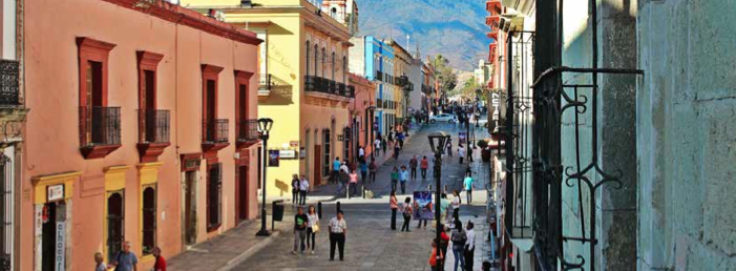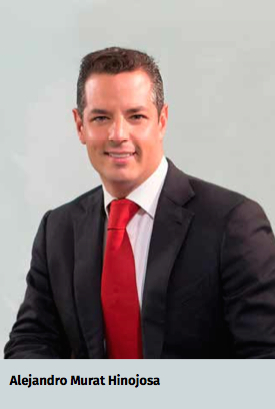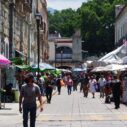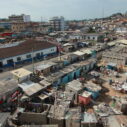
Search
How Has Poverty Reduction Been Achieved in Oaxaca, Mexico?

The state of Oaxaca is located in southeast Mexico. It has a population of almost four million people residing in its 570 municipalities. Historically, it has been one of the poorest states in the country, but that trend is reversing. We spoke with Oaxaca’s governor, Alejandro Murat Hinojosa, about how they are using multidimensional measurement to tackle poverty.
How would you describe poverty in Oaxaca in historical terms?
Throughout the 20th century and first decades of the 21st, Oaxaca has been the state with the highest percentage of poverty in Mexico. From 2008 and 2016, specifically, the trend in Oaxaca was an increase in poverty, according to a report by the National Council for the Evaluation of Social Development Policy (CONEVAL) entitled ‘10 Years of Measuring Poverty in Mexico, Advances and Challenges in Social Policy’ (2008 to 2018).
In the final year of the previous government (2016), Oaxaca reached its highest recorded level of multidimensional poverty (70.4%). In the year that I became governor, 2.8 million Oaxacans lived in poverty, and 26.9%, the equivalent of over one million people, lived in a situation of extreme poverty.
As of 2017, this trend began to reverse. In 2018, the last year analysed by CONEVAL, Oaxaca had taken powerful steps to tackle poverty. Not only did we achieve reductions in the number of indicators with social deprivations, but we also did it a higher proportion compared to the national average. The population living in poverty and extreme poverty decreased by 4 percentage points and 3.6 percent- age points, respectively. In fact, Oaxaca is the state in Mexico that, in terms of percentages, registered the greatest reduction in extreme poverty in the country between 2016 and 2018, reducing it from 26.9% to 23.3%.
How have you used multidimensional measurement to create public policies to eliminate poverty?
The results of the multidimensional measurement of poverty that CONEVAL undertook allowed us to know exactly what the social deprivations were at the state level and at the municipal level in particular. Once the statistics and the results of the measurement were known, we conducted a qualitative assessment in order to learn about the life stories of residents of poor communities, their daily challenges, and the difficulties they face when exercising their social rights. These studies were conducted in collaboration with universities, research centres, and entities in civil society. We were able to achieve a comprehensive analysis, both quantitative and qualitative, which was the basis for planning and implementing public policies aimed at improving the living conditions of poor populations.
Thanks to this analysis, we were able to create a tool for planning and coordination, focused at the municipal level, called ‘E-40’. This was a strategy for prioritizing and paying continuous attention to municipalities with the largest number of people, in relative and absolute terms, who are living in a situation of extreme poverty in Oaxaca. In addition to setting short-, medium- and long-term actions to confront social deprivations, this tool allows us to focus on budgetary, physical, and human resources, and public policies in the poorest municipalities in Oaxaca. This is indispensable in a state with the demographic characteristics of Oaxaca, which consists of 570 municipalities with over 13,000 localities, 45% of which have fewer than 2,500 inhabitants.
Our poverty reduction strategy defines criteria for coordinated implementation that involves all governmental agencies in the municipal, state, and federal governments, as well as academia, the production sector, and civil society. That strategy is built on three cross-cutting themes: (1) women; (2) girls, boys, and adolescents; and (3) indigenous peoples.
 What public policies have been implemented in Oaxaca to reduce multidimensional poverty?
What public policies have been implemented in Oaxaca to reduce multidimensional poverty?
In my administration, we recognize that poverty is a multi-causal phenomenon and is a response to many variables besides income. Thus, the public policies that we have designed have two fundamental elements: one is economic and one is social.
Public and private investment came about as a result of strengthened governance, an increase in investor confidence, and the improvement of available infrastructure. These investments generated formal employment, increased income for the population, and stimulated the economy in general.
As a result, in the last two years, according to the 2018 National Survey of Household Income and Expenditure of the National Institute of Statistics and Geography (INEGI in Spanish), the current quarterly income per household has increased by 3,888 pesos (about USD 200). Furthermore, 3.6% of Oaxacans rose above the poverty line established by CONEVAL, that is, 119,000 people overcame the condition of income-based poverty.
The increase in income and the implementation of programs such as Community Kitchens, Cold School Breakfasts, and Nutrition Aid for Vulnerable Individuals has facilitated a reduction of the deprivations in access to nutrition by 3.5 percentage points. In 2018, 126,637 more people were able to eat a healthy, varied, and sufficient diet.
Lack of access to social security has decreased by 1.7 percentage points, which means that a population of over 35,000 people can now enjoy those services. That decrease in percentage points was the highest in the country.
Regarding the social aspect, public policies were implemented to reduce social deprivations contributing to multidimensional poverty. For example, in 2018, 435,675 more people had access to basic services than in 2016, thanks to actions like the Water Supply and Sanitation Sector Modernization Operation ‘Mas Oaxaca’. Deprivation in basic housing services was 3.7 percentage points lower compared to 2016.
We also spurred a housing programme that enabled 119,000 people in Oaxaca to build solid walls for their homes, which in turn has made a significant contribution to a reduction in deprivations in terms of the quality and spaces of Oaxacan houses.
Finally, the Youth and Adult Education Programme enabled over 23,000 people to receive certificates of completion in basic education over these past two years.
What made it possible to implement these public policies?
The effective implementation of public policies in Oaxaca was based on three core foundations.
The first is defining the strategy to tackle poverty. At the beginning of my administration, we identified the factors that affected poverty and extreme poverty, and, at the same time, we established a roadmap with specific actions and clear goals, focusing the budget and tasks assigned to Cabinet members. The Ministry of Social and Human Development identified social deprivations by municipality and locality in an interactive map that clearly highlighted the main social deprivations in each vulnerable population centre.
We established a dashboard where every Cabinet member was required to report actions on a monthly basis.
Second is inter-institutional coordination. Public policy actions were executed in a coordinated fashion at all levels of federal, state, and municipal government. This made the programs more efficient by avoiding duplications or contradictions, improving results through more flexible and agile implementation. In addition, it actively involved civil society, the production sector, and academia. The combination of will and effort has allowed a community to develop.
The third is on-going monitoring and evaluation of strategy at the highest level. We established a dashboard where every Cabinet member was required to report actions on a monthly basis, so that we could evaluate whether established goals were met from the start of the strategy. Furthermore, there were field visits to verify whether what had been reported as finished actually had been completed.
What is the current situation of multidimensional poverty in Oaxaca?
In spite of the fact that over the past two years the trend has tended toward reversing the increase in poverty, 66.4% of the population in Oaxaca still endures at least one social deprivation and does not have sufficient income to cover all of their basic nutritional and non-nutritional needs.
Although the advances in the fight against extreme poverty in Oaxaca meant that it was the state with the greatest reduction (in percentage points) in extreme poverty in the period in question, still, in 2018 23.3% of the population lived in conditions of extreme poverty.
Without a doubt, we face enormous challenges in the fight against poverty and extreme poverty. Analysis of the figures in the CONEVAL report show that the five greatest sub-deprivations in the state are a lack of eco-friendly stoves, lack of access to social security, drainage, malnutrition, and school lag (specifically adults who have not completed secondary school).
The greatest sub-deprivation in the state is the lack of eco-friendly stoves. Over one million people use charcoal or wood for cooking, and their homes do not have chimneys. When it comes to the lack of drainage, this sub-deprivation affects 1.1 million inhabitants.
In contrast, just 0.9% of the population lacks access to electricity. Over 90% of Oaxacans have a roof over their heads, with just 0.6% of the population (24,000 people) lacking one.
The lack of social security is a very big challenge for Oaxaca, as it is for the rest of Latin America. It is the greatest social deprivation for the country and for Oaxaca. It can be summed up by two significant areas of opportunity: the first has to do with providing access to healthcare services and a retirement pension to 76.2% of Oaxacans (about three million people), and the second is for the production sector to generate fair conditions for their workers. There are currently 1.5 million people who are economically active and do not have access to healthcare and/or a pension for retirement.
The final measure of a sub-deprivation is access to food: it tells us that 27.9% of the population still faces this deprivation, that is, over one million people do not have a healthy, varied, and sufficient diet.
With regard to school lag, we still face great challenges dealing with the 27.1% of the population (over one million people) who do not have or have not completed their basic education. However, there has been significant progress in the fight against schooling lag among children aged 3 to 15 years old. However, it continues to be a big challenge given that currently 7.5% of this population segment does not attend primary or secondary school.
What are the plans in terms of public policies to continue to reduce poverty in Oaxaca?
There are several. Among them, promoting infrastructure macro-projects that facilitate connectivity and attract investment in strategic sectors in the medium-term, and also permit sustainable development in southeast Mexico.
We also want to keep strengthening social policy that contributes to developing conditions of wellbeing and prosperity for Oaxacan families. We will keep dealing with the factors that cause poverty both at the economic and the social level. For example, if the highest degree of social sub-deprivation in the state stems from the lack of eco-friendly stoves, that will be factored in when setting the budget for the following year in order to stimulate public policy that leads to reducing it in 2020–2021.
Furthermore, we are committed to continuing to identify problems of social development in communities and to the evidence-based evaluation of the results of social programs and actions, because this allows us to develop effective plans for short- and medium-term interventions to address lag and promote the economic activation of the most vulnerable populations.
To this end, we will strive to maintain and increase institutional coordination schemes by incorporating municipal government into a dynamic of cooperation and coordination, so that they generate social information that contributes to processes of strategic identification of the vulnerable population.
We will continue to consolidate strategic alliances with civil society, private initiatives, and academia, so that our work has a wider impact and greater transparency and efficiency.
Original in Spanish. Translated by Kristin Fisher.
This article was published in Dimensions 8.
















